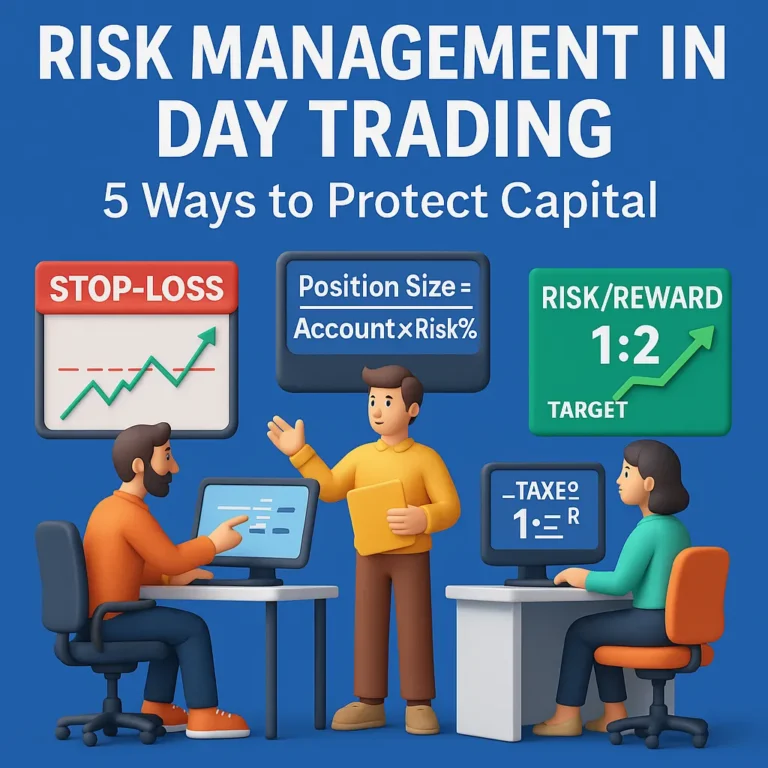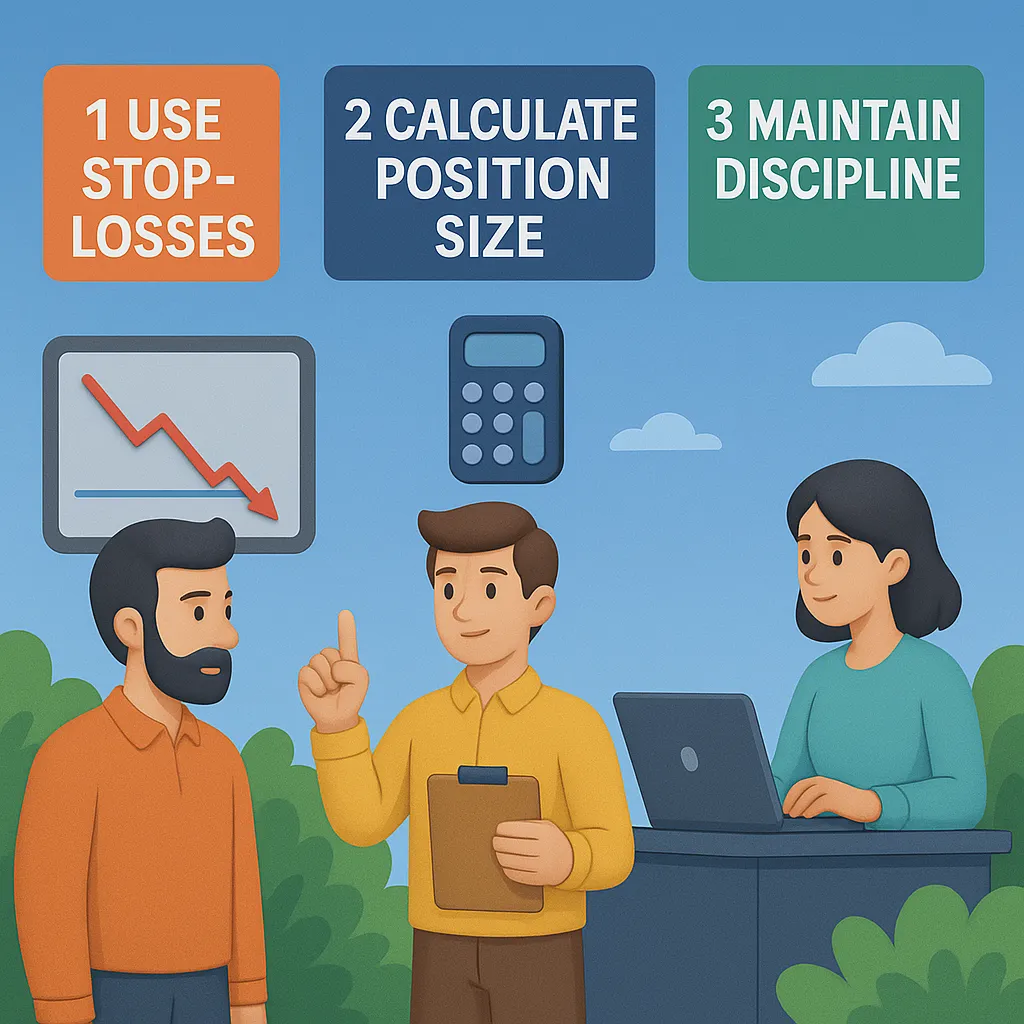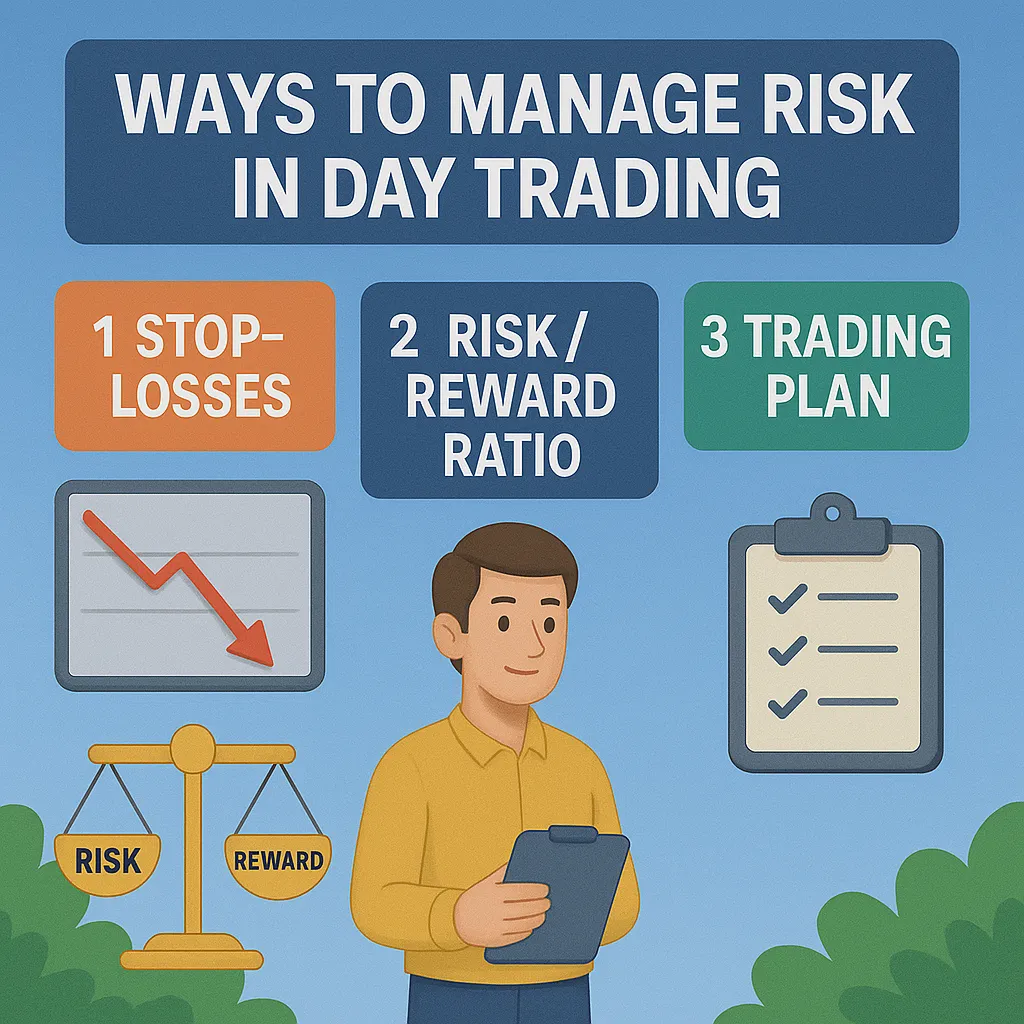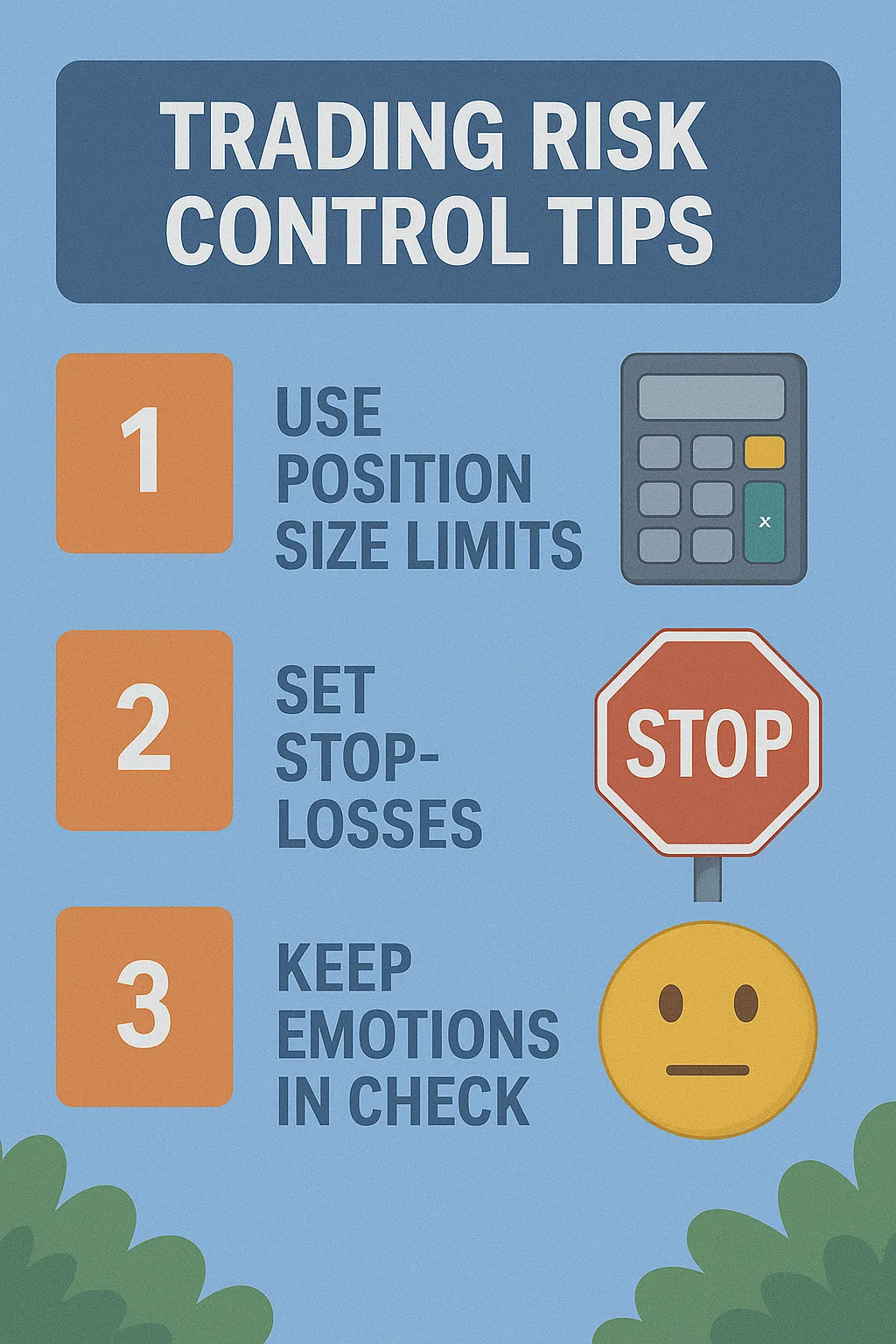
5 Ways to Manage Risk in Day Trading Without Losing It All
If you want consistency, risk management in day trading isn’t optional—it’s the whole game. This guide distills five battle-tested methods to cap downside and let winners run: defining risk/reward before entry, using hard stop-losses, sizing positions precisely, enforcing discipline rules, and journaling performance. You’ll also see how to adjust risk when volatility spikes and how to avoid the “death by a thousand cuts” that drains accounts.
Quick Summary
- Set a minimum risk/reward ratio (e.g., 1:2 or better) before you click buy.
- Place stop-losses at invalidation—not at random round numbers.
- Use formula-based position sizing (risk % × account ÷ stop distance).
- Create discipline rules (daily max loss, no revenge trades, cool-off timers).
- Journal entries/exits/psychology; iterate weekly to fix leaks.
New to day trading? Level up with Day Trading Mentor, sharpen entries with Swing Trade Entry Points, and expand your foundation via 10 Best Day Trading Books.
Last updated: • Reading time: ~12–15 minutes
Way #1 — Define Risk/Reward Before Entry

Solid risk management in day trading begins with a clearly defined risk/reward ratio. If your target is not at least 2× the distance of your stop-loss, the trade usually isn’t worth taking. Many new traders lose because they accept poor ratios without realizing how fast probabilities compound against them. A 40% win rate at 1:2 risk/reward can still make you profitable—while a 60% win rate at 1:1 barely breaks even.
For practical guides, Investopedia’s Risk Management primer explains why defining payoff upfront keeps your capital safe. Always map the trade on your chart before hitting buy.
Way #2 — Place Smart Stop-Losses (Not Guesswork)
Too many traders place stops at random whole numbers or “where it feels safe.” Effective day trading risk control means stops must sit at invalidation levels—points on the chart that prove your thesis wrong. Anything else leaves you open to normal noise. Smart traders use recent highs/lows, ATR multiples, or structural levels to anchor stop placement.
According to CME Group’s guidance on trading risk controls, disciplined stop placement separates sustainable traders from gamblers. It’s not about avoiding every loss—it’s about making losses affordable and predictable.
For further structure, pairing stop-loss rules with resources like Day Trading Mentor can keep you accountable when emotions tempt you to override your plan.
Way #3 — Position Sizing That Protects You

Proper position sizing is a cornerstone of risk management in day trading. The formula is simple:
Account × Risk % ÷ Stop Distance = Position Size.
For example, with a $10,000 account, risking 1% ($100) and a stop of $0.50, you can take 200 shares. This ensures no single trade costs you more than your preset threshold.
Many traders skip this math, risking random amounts that lead to oversized drawdowns. As SEC investor education notes, controlling risk per trade is one of the most reliable ways to stay in the game long enough to gain an edge.
Way #4 — Discipline Rules You Actually Follow
Most traders don’t blow up from one bad trade—they implode from breaking rules repeatedly. Strong day trading discipline strategies mean setting personal guardrails and enforcing them. Examples: stop after three losses in a row, cap daily drawdown at 3%, no revenge trading, and mandatory breaks after emotional trades.
Studies cited by Psychology Today on trading psychology emphasize that discipline is not just willpower—it’s structure. Write down rules, automate them in your platform, and share them with a trading mentor or peer for accountability.
Want Professional Risk Training?
Learn how to size trades, manage losses, and stay disciplined with structured mentoring and resources.
Start with a Day Trading MentorWay #5 — Journal, Review, and Improve (Your Feedback Flywheel)

The fastest path to better risk management in day trading is a tight feedback loop. Track every trade’s thesis, entry/exit, trading risk/reward ratio, stop location, size, outcome, and emotion markers (FOMO, revenge, hesitation). Each week, tag patterns and create one new rule that addresses your biggest leak. Next week, verify the rule reduced drawdowns.
- Win rate vs. average R multiple (are winners ≥ losers × 2?).
- Average risk per trade (≤ 1–2% of account?).
- Top three reasons for losses (late entries, moving stops, chasing?).
- Rule upgrade for next week (one change only; measure impact).
To reinforce habits, pair your journal with an accountability loop: a mentor, peer review, or our Day Trading Mentor resources. Over time, this turns managing losses in trading into a system—not a mood.
Your Daily Risk Playbook (Copy & Paste)
- Pre-market: define setups with ≥1:2 RR; pre-place alerts.
- Per trade: calculate size =
Account × Risk% ÷ Stop distance. - Execute: place stop at invalidation; no widening after entry.
- Session guardrails: 3-loss stop or −3% daily max drawdown.
- After close: log trades, tag errors, and set one rule to fix.
Sharpen entries with Swing Trade Entry Points and build long-term discipline from our reading list: 10 Best Day Trading Books.
External Guides & Risk Control Resources
Ground your day trading risk control in authoritative research and practical frameworks:
📘 Investopedia: Risk Management
Core definitions and examples to structure your risk plan.
🛡️ CME Group: Risk Controls
Practical controls for stops, sizing, and limits across markets.
⚖️ SEC: Investor Education
Official guidance on trading risks and protecting retail capital.
🧠 Psychology Today
Behavioral tools to curb overtrading and emotional errors.
📰 MarketWatch: Day Trading
News and features on risks, regulation, and trader behavior.
Keep sharpening your edge with our internal primers: Day Trading Mentor, Day Trading Books, and Swing Trade Entry Points.
FAQs — Risk Management in Day Trading
What is the golden rule of risk management in day trading?
Never risk more than 1–2% of your account on a single trade. This prevents a losing streak from wiping out your capital.
How do I calculate the ideal trading risk/reward ratio?
Divide potential reward (distance from entry to target) by potential risk (distance from entry to stop). Ratios of 1:2 or higher are generally favorable.
What’s the best way to handle managing losses in trading?
Accept them as tuition. Keep each loss small and review your journal to turn mistakes into rules. Losses are data, not personal failures.
Why are day trading discipline strategies so important?
Without discipline, traders overtrade, widen stops, and chase setups. Discipline enforces consistency, which is the only way to compound an edge.
What resources can help me build day trading risk control faster?
Use accountability from mentors, structured journaling, and books that teach risk-first strategies. Try resources like our Day Trading Mentor.
Conclusion — Protect Capital, Trade With Conviction
The truth about risk management in day trading is simple: those who prioritize it survive long enough to thrive. These five methods—risk/reward ratios, smart stops, position sizing, discipline rules, and journaling—convert randomness into structure. Whether you’re a beginner or scaling up, make risk control your first trading strategy.
Trade Smarter With Risk Controls
Level up your skills and avoid costly mistakes. Learn risk-first trading with resources built for day traders.